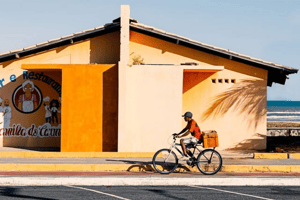Route Optimization for Delivery: The Key to Saving Time and Money
Everything you need to know about Routing and Its Types
Implementing effective routing for delivery operations is a strategic approach to managing and scaling the delivery process efficiently.

In this article:
- Definition of Routing in Delivery Operations
- Types of Routes
- Static Routes
- Dynamic Routes
- Multi-Stop Routes
What is Routing in Delivery Operations?
Routing is a comprehensive end-to-end process encompassing the strategic generation and selection of the most efficient delivery path. It involves determining the optimal delivery route and planning a sequence of stops to ensure multiple deliveries are completed within a single task.
Routing empowers dispatchers to enhance delivery operations by minimizing travel time, distance, and fuel consumption, all the while factoring in critical considerations like delivery schedules, route restrictions, peak-hour traffic, and various other variables.
Multiple factors are considered when creating a routing plan for specific delivery tasks. These factors include:
Managing & Optimizing Route Sequences
After capturing the orders, planning involves creating an optimal delivery route. It includes adding various permutations and combinations to group orders within the same geographical area and arranging them in the most efficient sequence to ensure multiple deliveries are executed on a single route without disturbing SLA adherence.
Considering External Conditions
While creating a routing plan, it is advisable to consider route conditions, peak hour traffic time, the probability of a vehicle breakdown, and any route regulations. This comprehensive approach ensures that Estimated Time of Arrivals (ETAs) for the planned deliveries can be accommodated, considering the dynamic conditions that could impact the delivery process.
Vehicle Capacities
In delivery operations, especially within the e-commerce and courier express parcel industry, the size of shipments can vary significantly from one order to the next. When generating a route plan for a specific delivery, it's essential to account for the capacity of the delivery vehicle to ensure that it can effectively accommodate the varying shipment volumes.
Types of Routes
Every delivery operation has unique requirements, and dispatchers need to select various route types to align with these expectations. Here are some commonly employed route types that cater to diverse delivery operations.
Static Routes
Static Routes refer to delivery routes that remain relatively unchanged over time. These are typically favored by delivery operations that have regularly scheduled deliveries. The routes are generated based on the orders to be delivered. In this approach, the route plan is generated once and adhered to on a consistent basis.
These routes are commonly used in deliveries where regular orders are created and the volume of orders is also pre-decided. The driver picks the order, follows the same route with the same sequence of stops ( if required), and completes the deliveries. Businesses engaged in frequent and consistent deliveries, such as e-grocery companies providing daily milk and dairy product supplies or pharmaceutical delivery businesses ensuring continuous delivery of specific medications for extended periods, often find static routes ideal. This approach suits businesses with smaller, well-established delivery networks and helps maintain a predictable and reliable delivery schedule.
While some businesses continue to rely on the conventional static routing process, there are notable drawbacks. These include the failure to optimize routes, the inability to track the real-time location of drivers, communication gaps, and challenges when trying to scale existing operations. These limitations explain why businesses need to explore more dynamic and efficient routing solutions.
Dynamic Routes
Dynamic routes are optimized delivery routes generated from scratch, allowing dispatchers to factor in critical considerations such as traffic & weather conditions and vehicle & driver availability. As the number of delivery tasks changes, these routes can be adjusted to ensure that every delivery is time-sensitive and cost-efficient.
Due to its notable advantages, dynamic route planning is increasingly embraced in delivery operations. It provides real-time visibility of delivery drivers' locations, which enhances communication and transparency for all stakeholders. Additionally, it empowers businesses to scale their operations effectively by continuously optimizing routes at each stage of the delivery process, ensuring efficiency and cost-effectiveness.
Businesses in e-commerce deliveries, furniture deliveries, and appliance deliveries frequently choose dynamic routing as their preferred approach. Dynamic routes are carefully crafted while considering critical factors such as vehicle capacity, order volume, and road traffic conditions. Delivery operations within these industries often require real-time adjustments, ensuring optimal and dynamic route planning that enables efficient deliveries, even when faced with shifting variables and fluctuating demands. This adaptability is crucial to meeting the evolving needs of these industries.
Multi-Stop Routes
Multi-stop routes are delivery routes where multiple stops are planned for the delivery agents. These stops are strategically incorporated into the route plan by creating orders based on their location and committed delivery timeframes. The driver is responsible for covering multiple stops and delivering orders to each planned destination, optimizing the delivery process to ensure efficiency and timeliness.
This type of route is especially popular in the courier, express, and parcel industries, where a cluster of orders needs to be fulfilled within a single day. It's an efficient approach for ensuring that multiple deliveries are completed in a timely and cost-effective manner, meeting the demands of these fast-paced industries.
Selecting the Right Route
Businesses with varying delivery commitments may need to choose the most suitable route type based on their needs. Each route type offers unique characteristics and advantages. For example, in delivery operations where the quantity and type of orders are predetermined, static routes are the optimal choice. On the other hand, in the Courier, Express, and Parcel (CEP) industry, multi-stop routes are highly effective. Dynamic routing, on the other hand, proves to be a valuable asset in supporting e-commerce deliveries. The choice of route type largely depends on the specific requirements and nature of the business.
Feel free to contact our experts to discover which route plan aligns best with your delivery operations and enables scalability.



